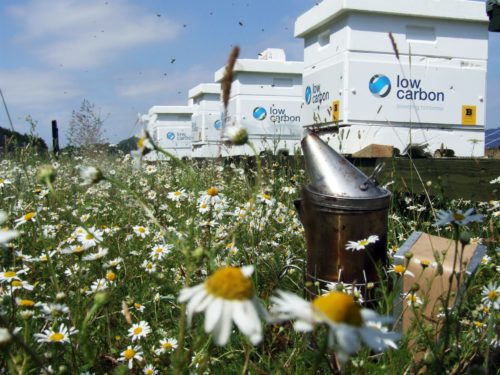The Project
The site extends to approximately 40 hectares (ha) / 98 acres in size. The road network in the vicinity of the site comprises the B4265 located to the north of the Site, which links Rockshead Lane which runs alongside the eastern boundary of the site and Fonmon Road which runs on the western boundary of the site. Both roads connect to the Port Road to the south.
The specific infrastructure proposed comprises:
-
- Photovoltaic (PV) panels to a maximum height of 3m
- Mounting frames – matt finished small section metal structure pile driven into the ground, voiding the need for substantive foundations;
- Scheme of landscaping and biodiversity enhancement;
- Central Inverters (inverters and transformers will be housed together in prefabricated containers to a maximum height of 3m), substations (DNO and customer to a maximum height of 4.1m) and associated cabling (below ground);
- Point of connection
- Stock fencing up to a height of 2m
- Infra-red CCTV (CCTV cameras would operate using motion sensors and would be positioned inward only to ensure privacy to neighbouring land and property);
- Temporary set down areas
- Internal service tracks
- Site access for the construction, operational and decommissioning phases


This scheme will have an export capacity of circa 35MW – this is equivalent to:
Homes powered
Tonnes of CO2 saved from emission
Cars removed from the road
Why Solar?
Solar farms are a simple and established technology providing a source of safe and clean energy which produces zero emissions when in operation. Solar energy projects have a low visual impact potential if designed correctly, have no moving parts, meaning maintenance requirements are low through the lifetime of the project, and are considered ‘temporary’ as they are easily decommissioned at the end of their lifetime. Biodiversity enhancements, and ongoing agricultural use of the land (animals such as sheep can continue to graze the land around the solar panels) for example means that this technology can operate alongside traditional land uses very easily.
Welsh Government has acknowledged that there is a climate emergency and has committed to decarbonising and tackling the causes of climate change over coming years. Generating renewable energy is a key part of that commitment and Welsh Government has set ambitious targets for the generation of renewable energy, including:
- For 70% of electricity consumption to be generated from renewable energy by 2030.
- For one gigawatt of renewable energy capacity to be locally owned by 2030.
- For new renewable energy projects to have at least an element of local ownership from 2020.
Through the development and delivery of East Aberthaw Solar Farm, we hope to provide a significant contribution towards these targets.

Benefits
Community Buy-In Scheme: In addition to the significant capital investment in the local area, and broader employment and supply chain benefits, we are also looking to explore opportunities to deliver community benefit and/or community ownership in some form. We would be grateful for local feedback on this point and we would be pleased to consider all options in this respect. In the past we have either made a local financial contribution to the local area, or have worked closely with the local community to deliver community owned solar farms.
Biodiversity Enhancements: Biodiversity enhancements are central to our thinking during the development of the proposals. We are assessing the baseline conditions to protect existing ecology on the site. We will also create opportunities for improvement of habitats wherever possible. Opportunities to enhance local biodiversity include the improved management of grassland in and around the site and reinforcement of hedgerows to improve habitats for a range of species. We hope that this increase in botanical diversity will lead to an increase in invertebrate diversity, which in turn will provide significant benefits for birds, bats, small mammals and other species.
Supply Chain: Economic benefits will arise through the provision of temporary jobs and supply chain services during the construction phase. It is estimated that there will be up to 150 construction jobs created including both direct jobs on-site and indirect roles in the wider economy. The construction phase would also have indirect effects due to the workforce spend in the area.
Opportunities will be taken to maximise the use of local labour sources and suppliers, through the local sourcing of materials, where possible. This will increase income and expenditure in the area and will create positive economic benefits for the local economy. We will actively seek to use local resources (labour and materials) where possible during the construction phase.
Get in touch with us to register your interest as a supplier or for job opportunities.